Dwarf Galaxias
Dwarf GalaxiasGlaxiella pusilla | |
|---|---|
| Kingdom: | Animalia |
| Phylum: | Chordata |
| Class: | Actinopterygii (ray-finned fishes) |
| Order: | Osmeriformes (formerly Salmoniformes) |
| Family: | Galaxiidae |
| Status | |
| World: | Vulnerable (IUCN) |
| Australia: | Vulnerable (EPBC Act listed) |
| Victoria: | Endangered (FFG Threatened List 2025) |
| FFG: | Listed Action Statement No. 258 pdf |
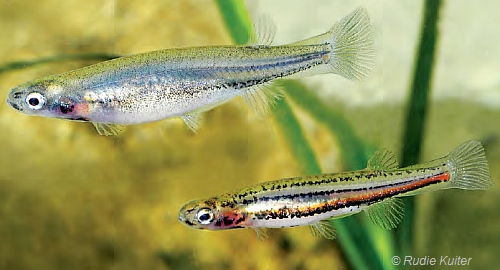
Image: Rudie Kuiter, Aquatic Photographics.
The Dwarf Galaxias (Galaxiella pusilla) is a very small, scaleless and elongated native freshwater fish. and one of four members of the genus Galaxiella in Australia, other members being; Galaxiella toourtkoourt south-west Victoria to south eastern South Australia, Galaxiella munda and Galaxiella nigrostriata, which are both located in southern Western Australia (Coleman et al. 2015, Fishbase 2007, Waters et al. 2000).
A review of the Dwarf Galaxias (Galaxiella pusilla) in 2015 has resulted in the description of two distinct species across what was previously considered one species. The revised distribution of Galaxiella pusilla s.s. has reduced its range by approximately 60% (Coleman et al. 2015).
The conservation status of Dwarf Galaxias and Little Galaxias was re-assessed from Vulnerable in 2013 (DSE 2013) to Endangered in 2020 as part of the Conservation Status Assessment Project – Victoria (DELWP 2020). This species remains listed as Endangered in Victoria under the Flora and Fauna Guarantee Act 1988 - Threatened List - (FFG Threatened List 2025).
Dwarf Galaxias (Galaxiella pusilla) - is now only known from the Mitchell River Basin near Bairnsdale, west to Dandenong Creek near Melbourne in Victoria, Flinders Island in Bass Strait and north-eastern and north-western Tasmania.
Little Galaxias (Galaxiella toourtkoourt) - is now known to occur from the upper Barwon River system near Barwon Downs, Victoria, west to the Cortina Lakes, near the Coorong, South Australia. The common name Little galaxias is based on it being the smallest species in the Galaxiidae. The scientific name toourtkoourt is from the Australian indigenous language groups Tjapwurrung, Korn Kopan noot, and Peekwurrung, meaning ‘little fish in freshwater’ (Coleman et al. 2015).
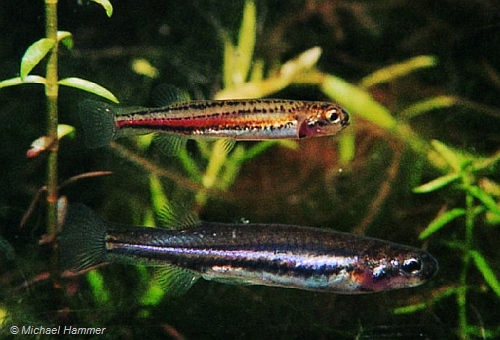
A comprehensive description of Dwarf Galaxias and Little Galaxias is contained in Coleman et al. (2015). Similar to other Galaxiids the Dwarf Galaxias has a single dorsal fin situated well back commencing behind anal fin, distinguishing features include rounded caudal fin with fleshy flanges extending from the tail which almost join with the anal and dorsal fins. There are three black longitudinal stripes on each side of the body. In the spawning season males have a bright orange stripe between the middle and lower black stripes and females have a silvery-white stripe between the middle and lower dark stripes. Males range from 29-34mm whereas females range between 39-48mm (Last et al. 1983, Allen et al. 2002, Saddlier et al. 2006).
Distribution
Victoria
Dwarf Galaxias Galaxiella pusilla was once considered widespread across southern Victoria but is now only known from the Mitchell River Basin near Bairnsdale, west to Dandenong Creek near Melbourne in Victoria, Flinders Island in Bass Strait and north-eastern and north-western Tasmania.
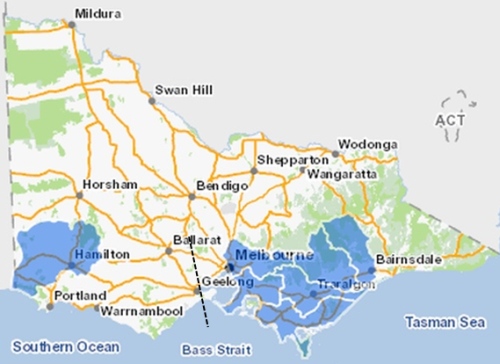
Little Galaxias - areas west of dotted line. (Based on Colman et al. 2015 & VBA 2024)
Ecology & Habitat
The Dwarf Galaxias is found in shallow, slow-flowing or swamp like situations which contain either permanent or intermittent water provided there is abundant submerged and emergent vegetation (Backhouse & Vanner 1978, Humphries, 1986). They generally prefer to stay in close proximity to the edge of the waterbodies due to protection provided by the aquatic vegetation such as rushes (Juncus sp.) and sedges (Lepidosperma sp.), but fish have been seen in open areas of water (Saddlier et al. 2006). At sites where water bodies are temporary or partially dry up the Dwarf Galaxias is thought to undertake some form of aestivation (dormancy in summer or dry seasons). The fish are only able to undertake aestivation when the water body they inhabit is also populated with burrowing crayfish (Geocharax sp.), where they utilise the crayfish holes in dry events.
Other critical habitat which is often utilised by the Dwarf Galaxias, particularly in extended dry conditions are areas which naturally connect wetlands to a river or creek (Saddlier et al. 2006). The Dwarf Galaxias has a remarkable capacity to travel great distances overland between different pools, provided there is flowing water of no less than 2cm deep connecting these pools (Beck 1985).
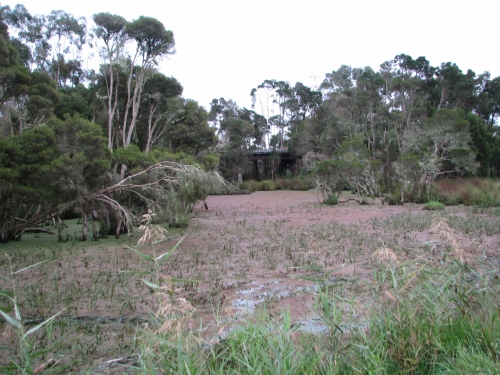
Life cycle
The Dwarf Galaxias is thought to be an annual species, where adults die after spawning. Therefore it is vital to have successful recruitment each year, or severe declines in populations will occur, potentially leading to the extinction in certain areas (Humphries 1986, Saddlier et al. 2006).
The entire life cycle of the Dwarf galaxias is completed in freshwater. It spawns in late winter to spring, August and September (Koehn & O'connor 1990) with the female laying (singly) between 65-250 eggs. Spawning extends over several days with approximately 10 eggs laid per day. The egg size is typical of a non-migratory freshwater Galaxiid (0.6-1.3mm), whereas compared to migratory and estuary fish Galaxiids have smaller quantities but they have larger sized eggs. The female attaches the eggs usually to the underside of vegetation or hard surfaces like a leaf or stone. After the female has laid the eggs two or three males fertilise them and then search for more ripe females. The larvae take between two-three weeks to hatch and are approximately 2 -4 mm in length. Adults are thought to die after spawning (Humphries 1986, Koster 2003, Saddlier et al. 2006).
Feeding
The Dwarf Galaxias is a generalist carnivore that feeds mainly on zooplankton, where planktonic crustaceans and chironomids can be the main sources of their diets but they have also been observed feeding on filamentous algae (Cadwallader & Backhouse 1983, Humphries 1986).
Threats
The Dwarf Galaxias is considered vulnerable in Victoria due to threats which have significantly impacted upon its distribution and abundance and the continuation of threats such as habitat destruction and potential predation from introduced species which are likely to lead to extinction. It was recommended for listing under the Flora & Fauna Guarantee Act 1988 in 1991. Coleman et al. 2015 recommend both the Dwarf Galaxias and Little Galaxias should be considered nationally ‘endangered’
Habitat loss and fragmentation
This is a major threat to the survival of Dwarf Galaxias populations with wetlands and other waterbodies being either destroyed or altered by human activity (Beck 1985, Saddlier et al. 2006). In Victoria less than 1% of wetlands previous to European settlement currently exist, and many of this 1% has been altered in some way through increased flows or nutrient flows (Koehn & Morison 1990). In urban areas the installation of concrete drains instead of natural vegetation, has caused a substantial increase in creek and waterway flows due to the lack of obstructions from fallen vegetation etc. and the lack of natural bends in these urban waterways (S. Spathis pers. comm.). The Dwarf Galaxias does not tolerate fast flowing water (Beck 1985, Backhouse & Vanner 1978, Saddlier et al, 2006).
Drainage of wetlands
Drainage causes direct loss of habitat, fragmentation of populations and subsequent consequences such as a decrease in genetic diversity may occur, which would lower the species genetic fitness and survival (Koster 2003 & Threatened Species Section 2006, O’Dwyer 2007).
Loss of burrowing crayfish
The loss of Geocherax sp. through predation, change in hydrological flows and habitat loss is a key threatening process to the Dwarf Galaxias. The reliance of the Geocherax sp. burrows for refuge in dry times and for protection from other species consequently means that this species of yabbie and its subsequent requirements such as diet must also be maintained to prevent the extinction of the Dwarf Galaxias (Beck 1985, Saddlier et al. 2006, Threatened Species Section 2006).
Degraded streamsides
Because riparian vegetation is utilised by the Dwarf Galaxias as both habitat and a food source it is important to maintain the integrity of wetland and streamside vegetation. Damage to this vital resource by clearing or uncontrolled stock access damages habitat and increases the risk of sedimentation and deterioration of water quality. Drainage of wetlands that are capable of supporting populations of Dwarf Galaxias reduces the population viability.
Beyond the Dwarf Galaxias’s immediate habitat, damage to streamside vegetation within the catchment can lead to increased run off, sedimentation, flow of chemicals and nutrients from the land into the water which can impact on the Dwarf Galaxias habitat even though these impacts may be some distance away.
Altered hydrological flows
Clearing and plantation practices also posses a threat to the habitat of Dwarf Galaxias and Little Galaxias through reduced water yields (Saddlier et al. 2006).
Introduced aquatic species
Redfin Perca Fluviatilis, Brown Trout Salmo trutta and Gambusia can impact on Dwarf Galaxias and Little Galaxias through direct predation and competition for habitat. The Common Yabbie Cherax destructor is recognised as a problem because it destroys aquatic vegetation and increases turbidity in the water. It has been identified as a threat in Tasmania and has been declared a noxious species there due to its ability to reduce the quality of habitat for native species such as the Dwarf Galaxias (Threatened Species Section 2006, Saddlier et al, 2006).
Conservation & Management
Both Dwarf Galaxias and Little Galaxias occur through a variety of different land tenures e.g. National Parks, urban reserves, state forest, heritage rivers and private land/other tenures. These different land/water tenures divide the responsibility of the Dwarf Galaxias and Little Galaxias habitat to the corresponding agencies or individual stakeholders which could interfere with the implementation of future management actions. In Victoria, 42 locations have been identified as important areas for management actions.
Key Local Government Areas containing Dwarf Galaxias
PORT PHILLIP AND WESTERNPORT
Cardinia Shire - Cannibal Creek, Diamond Creek.
Casey City - Cardinia Creek (upper).
Kingston City - Braeside Park (stocked in 2002).
Mornigton Peninsula Shire - Devil Bend & Bittern Reservoirs and Creek.
WEST GIPPSLAND
Baw Baw Shire - Five Mile Creek, Moe River.
Latrobe City - Loy Yang Creek, Moe Contour Drain, Morwell River Wetlands, Wades Creek, Waterhole Creek Swamp, triutary of Boyds Creek.
SOUTH GIPPSLAND
South Gippsland Shire - Silver Swamp.
Wellington Shire - Bruthen Creek Deep Creek North of Yarram, Dingo Creek, Flooding Creek, LaTrobe River, Merriman Creek, Monkey Creek, Perry River, Sale Common, Long Waterhole - Longford.
EAST GIPPSLAND
East Gippsland Shire - Cobblers Creek, Darby River.
Key Local Government Areas containing Little Galaxias
SOUTH WEST VICTORIA
Glenelg Shire - Crawford River, Ellengowan wetland - Tyrendarra, Fitzroy River, Glenelg River, Kangaroo Creek, Long Swamp, Shaw River, Wannon River, Bridgewater Lakes, Eumeralla River.
Colac Otway Shire - Gosling Creek.
Corangamite Shire - Mt Emu Creek/Blind Creek.
Moyne Shire - Moyne River.
Pyrenees Shire - Barkly Flora Reserve, Fiery Creek.
Southern Grampians Shire - Dwyer Creek, Yatmerone Swamp Wildlife Reserve and Murdum Creek, Penshurst.
Surf Coast Shire - Barwon River
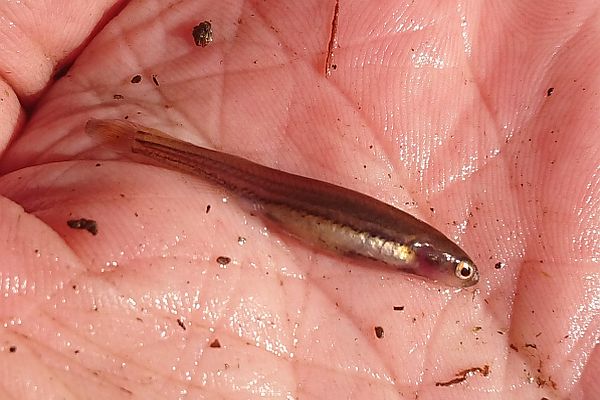
Key management activities
Education and awareness; raising community awareness and working with landholders to protect Dwarf Galaxias habitat through retention of wetlands, protection of riparian zones and control of fertilizer run off assists with conservation of this species.
Habitat Restoration; fencing and revegetation of streams and wetlands wetlands being primarily undertaken through the Glenelg Hopkins Catchment Management Authority.
Monitoring; all critical populations of Dwarf Galaxias should be monitored and their habitats also monitored for quality (both water and vegetation) and habitat quantities (Beck 1985, Koster 2003, Saddlier et al. 2006). This is being carried out through an on-going monitoring program.
Research; it is important to improve the understanding of species longevity, aestivation capabilities, species boundaries, population genetics and key habitat requirements (Koster 2003). Significant gaps in knowledge about specifics of the Dwarf Galaxias ecology are still unclear; for example aestivation is known to occur in association with the burrowing yabbies Geocherax sp. but how much dependence and times they can last in these burrows is uncertain. Population modelling and viability analysis of Dwarf Galaxias is being undertaken by fisheries ecologists from the Arthur Rylah Institute.
Translocation; assess options for possible re-introduction to restored habitats particularly where populations have suffered a decline due to past events. Conduct breeding trials with the aim of maintaining genetic diversity between populations.
Control of predator/competitor species; stocking of species such as trout and redfin should be avoided where Dwarf Galaxias are known to occur and where feasible species such as Gambusia and redfin should be reduced from habitats where populations of Dwarf Galaxias are under threat.
Projects & Partnerships
- Friends of Yatmerone at Yatmerone Swamp Wildlife Reserve near Penshurst.
- Surveys of Murdum Creek, Penshurst by Deakin University students.
References & Links
- Allen G.R., Midgley S.H., Allen M., (2002) Field Guide to the Freshwater Fishes of Australia, Western Australian Museum, Perth.
- Backhouse, G.N., Vanner, R.W., (1978) Observations on the biology of the Dwarf Galaxiid, Galaxiella pusilla (Mack) (Pisces: Galaxiidae) in Victorian Naturalist, Vol 95, No 4 Pages 128-132
- Beck, R.G. (1985) Field observations upon the dwarf galaxiid Galaxiella pusilla (Mack) (Pisces:Galaxiidae) in the South-east of South Australia, Australia in South Australian Naturalist 60(1): 12-22
- Cadwallader, P.L., Backhouse, G.N., (1983) A guide to Freshwater Fish of Victoria, Victorian Government Printing Office on behalf of Fisheries & Wildlife Division, Ministry for Conservation, Melbourne, Victoria.
- Coleman, R.A., Hoffman, A.A., Raadik, A.A. (2015) A review of Galaxiella pusilla (Mack) (Teleostei: Galaxiidae) in south-eastern Australia with a description of a new species. Zootaxa 4021 (2): 243–281 www.mapress.com/zootaxa/ http://dx.doi.org/10.11646/zootaxa.4021.2.2
- DEH (2003) Review of the Status of threatened Species in South Australia – Discussion Paper, Department for Environment and Heritage, Government of South Australia.
- DE (2016) Galaxiella pusilla in Species Profile and Threats Database, Department of the Environment, Canberra. Accessed 11 May 2016.
-
DELWP (2020) Provisional re-assessments of taxa as part of the Conservation Status Assessment Project – Victoria 2020, Department of Environment Land Water and Planning, Victoria.
- DSE (2013) Advisory List of Threatened Vertebrate Fauna in Victoria – 2013, Department of Environment, Land, Water & Planing, Victoria, East Melbourne, Victoria.
- FFG Threatened List (2025) Flora and Fauna Guarantee Act 1988 - Threatened List - March 2025, Department of Energy, Environment and Climate Action (DEECA), Victoria.
- Fish base 2007, Galaxiella munda, accessed 3 October, from http://www.fishbase.org/Summary/speciesSummary.php?ID=9464&genusname=Galaxiella&speciesname=munda>,
- Fish base 2007, Galaxiella nigrostriata, accessed 3 October 2007, from <http://www.fishbase.org/Summary/SpeciesSummary.php?id=9476>
- Flora & Fauna Guarantee Act 1988; Action Statement No. 258 Dwarf Galaxias Galaxiella pusilla, 2015, Department of Environment, Land, Water & Planning, Victoria. View as pdf
- Humphries, P. 1986. Observations of the ecology of Galaxiella pusilla (Mack) (Salmoniformes: Galaxiidae) in Diamond Creek, Victoria. Proceedings of the Royal Society of Victoria, Vol 98 Pages 133-137.
- IUCN (2016) http://www.iucnredlist.org/details/8820/0
- Koehn, J.D., Morison, A.K., (1990) A review of the conservation status of native freshwater fish inVictoria. Victorian Naturalist Vol 107 Pages 13-25 seen in Threatened Species Section, 2006, Recovery Plan: Tasmanian Galaxiidae 2006-2010. Department of Primary Industries, Water, Hobart.
- Koehn & O'connor (1990) Biological information for management of native freshwater fish in Victoria, Department of Conservation & Environment, Arthur Rylah Institute, April 1990.
- Koster W.M., (2003) Threatened fishes of the world: Galaxiella pusilla (Mack 1936) (Galaxiidae), Environmental Biology of Fishes, Vol 68, Page 268
- Last P.R., Scott E.O.G., Talbot F.H., (1983) Fishes of Tasmania, Tasmanian Fisheries Development Authority, Hobart.
- O’Dwyer C., (2007) ‘Lecture notes’, unpublished, Melbourne University, Melbourne Australia.
- SAC (Scientific Advisory Committee), 1991, Final Recommendation on a nomination for listing: Galaxiella pusilla (Mack, 1936) – Dwarf Galaxias (Nomination No. 141), Scientific Advisory Committee, Flora and Fauna Guarantee, Department of Conservation and Environment, Melbourne.
- Saddlier S, Jackson J, Hammer M, 2006, Draft Recovery Plan for Dwarf Galaxias, Galaxiella pusilla (Mack) 2005 – 2009, Department of Sustainability and Environment, Heidelberg, Victoria.
- Threatened Species Section (2006) Recovery Plan: Tasmanian Galaxiidae 2006-2010. Department of Primary Industries, Water, Hobart.
- VBA (2016) Victorian Biodiversity Atlas, Department of Environment, Land, Water & Planning, Victoria.
- Wager, R. 1996. Galaxiella pusilla. The IUCN Red List of Threatened Species 1996: Accessed: 11 May 2016.
Please contribute information regarding Dwarf Galaxias in Victoria - observations, images or projects. Contact SWIFFT

